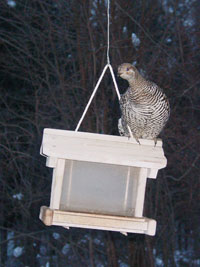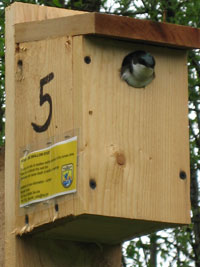Landscaping for Wildlife
Other Wildlife Enhancements
In addition to trees, shrubs, plants, and flowers, you can make your area more attractive to wildlife by providing other features that can meet other important habitat needs like water and cover. Take time to research different animals’ specific habitat requirements to find out if you can provide the particular food or cover it requires. Avoid placing any features attractive to wildlife near hazards such as electrical lines, exhaust systems, roads with high-speed traffic, and large-paned picture windows.
Water
Small pools of water on the ground may be more attractive to wildlife than elevated birdbaths, but remember that birds are more exposed to roaming cats when bathing on the ground. Add a trickling fountain or build a pond! A backyard pond can be as simple or complex as you like, and can be a haven for wildlife. Ponds with shallow, gentle-sloping shorelines, and of irregular shapes provide the best wildlife habitat. Logs and rocks along the pond edges, as well as small islands offshore will enhance the value of the pond to wildlife. Thick grasses and shrubs along part of the pond shore will provide nesting and roosting cover for some birds. However, if you or your neighbors have outdoor cats, avoid placing food or water close to such “hunting blinds.”
Feeders
 In the winter, bird feeders can attract a variety of birds. However, they can also spread
infections that can be deadly to large numbers of birds. Be sure to clean your feeders often (a mixture of 1 part ammonia
and 10 parts water kills most germs) and replace old seed with fresh seed frequently. In Alaska, we want to remove our
seed and suet feeders in the springtime, as they are a powerful attractant to black and brown bears alike. The onset and
duration of denning is variable; however, a good rule of thumb is to take down or empty feeders in early April and put
them back up in late October.
In the winter, bird feeders can attract a variety of birds. However, they can also spread
infections that can be deadly to large numbers of birds. Be sure to clean your feeders often (a mixture of 1 part ammonia
and 10 parts water kills most germs) and replace old seed with fresh seed frequently. In Alaska, we want to remove our
seed and suet feeders in the springtime, as they are a powerful attractant to black and brown bears alike. The onset and
duration of denning is variable; however, a good rule of thumb is to take down or empty feeders in early April and put
them back up in late October.
Snags & Nest Boxes
Dead trees, or snags, are often cut down as they are presumed to be of no value. However, snags provide feeding and drumming sites for woodpeckers, songposts for a variety of birds, and hunting perches for owls and hawks. Holes and cavities in snags provide nest sites and shelter from bad weather. If a snag doesn’t endanger your home or your neighbor’s, consider leaving it in place.
If adequate food and cover are available, nest boxes of various sizes can attract cavity-nesting birds to your property. Some birds that use nest boxes can eat hundreds or thousands of mosquitoes (e.g., swallows) or leaf-eating caterpillars (chickadees) each day. Specifically constructed “bat boxes” may encourage bats to take up residence and feed on your local mosquitoes! Bat boxes seem to work best when placed near water bodies.
Songposts
Songposts provide birds places to perch above other vegetation where they can see large areas, sing, be conspicuous, hunt flying insects, and detect predators. Fenceposts, clotheslines, or any pole will be used by singing birds, particularly in areas where shrubs and trees are sparse. Songposts should stick up a foot or more above surrounding vegetation.
Escape Cover
 A brush pile, rock pile, or even a log pile can make a great spot for wildlife to hide, find food, and even raise young. Dark-eyed juncos and snowshoe hares are particularly attracted by brush piles. In treeless areas, almost any sort of protection from wind will attract birds. Rock walls can also provide good cover and places for animals to build homes.
A brush pile, rock pile, or even a log pile can make a great spot for wildlife to hide, find food, and even raise young. Dark-eyed juncos and snowshoe hares are particularly attracted by brush piles. In treeless areas, almost any sort of protection from wind will attract birds. Rock walls can also provide good cover and places for animals to build homes.
Grit
Grit provided by a patch of sand or gravel will often attract seed-eating birds like ptarmigan, grosbeaks, sparrows, and crossbills. Some birds like to take dust baths in dry silt or fine sand.
Mud Puddles
Mud puddles will be used in spring by cliff swallows, if they are placed in open areas near buildings or cliffs where these birds can build their mud nests.
Predators
Predators should be a natural and welcome element in your Landscaping for Wildlife plan. Most people are thrilled at the sight of a sharp-shinned hawk or shrike, even when it is chasing chickadees at a bird feeder. However, “unnatural” predators, like outdoor cats, are an unnecessary drain on wildlife in urban and rural areas. A pet or stray cat can kill dozens, even hundreds, of small birds and mammals annually. If you own a cat, please keep them indoors, watch them when they are outdoors, and consider using a bell.
